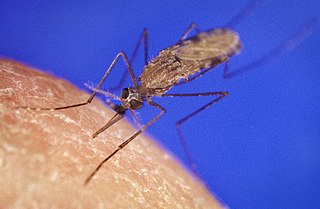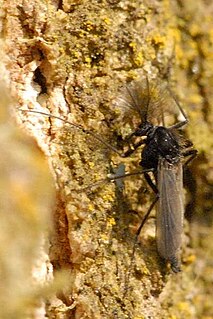
The Culicomorpha are an infraorder of Nematocera, including mosquitoes, black flies, and several extant and extinct families of insects.

A midge is any small fly, including species in several families of non-mosquito Nematoceran Diptera. Midges are found on practically every land area outside permanently arid deserts and the frigid zones. Some midges, such as many Phlebotominae and Simuliidae, are vectors of various diseases. Many others play useful roles as prey items for insectivores, such as various frogs and swallows. Others are important as detritivores, and form part of various nutrient cycles. The habits of midges vary greatly from species to species, though within any particular family, midges commonly have similar ecological roles.

The Chironomidae comprise a family of nematoceran flies with a global distribution. They are closely related to the Ceratopogonidae, Simuliidae, and Thaumaleidae. Many species superficially resemble mosquitoes, but they lack the wing scales and elongated mouthparts of the Culicidae. An example of mosquito-resembling species is Tokunagayusurika akamusi.

Chaoboridae, commonly known as phantom midges or glassworms, is a family of fairly common midges with a cosmopolitan distribution. They are closely related to the Corethrellidae and Chironomidae; the adults are differentiated through peculiarities in wing venation.
Conchapelopia is a genus of flies belonging to the family Chironomidae.

Orthocladiinae is a subfamily of midges in the non-biting midge family (Chironomidae). For lack of a better common name, they are simply referred to as orthoclads.

Chironomus is a genus of nonbiting midges in the subfamily Chironominae of the bloodworm family, Chironomidae, containing several cryptic species that can only be distinguished by experts based on the characteristics of their giant chromosomes. The larvae of several species inhabit the profundal zone where they can reach relatively high densities. They use a combination of hemoglobin-like proteins and undulatory movements in their burrows to obtain oxygen in poorly oxygenated habitats.

Tanytarsus is a large genus of non-biting midges of the tribe Tanytarsini and subfamily Chironominae of the bloodworm family (Chironomidae). The larvae of these insects occur in a wide range of freshwater habitats with some species being marine.
Stictochironomus is a genus of non-biting midges in the subfamily Chironominae of the bloodworm family Chironomidae. Members of this genus often have strongly marked wings and legs. The larvae of these midges may also have distinct dark patterns on the dorsal side of the head capsule. They live in sand and other sediments in a variety of fresh water habitats in densities of several hundred per square meter.
Tanypodinae is a subfamily of midges in the non-biting midge family (Chironomidae). The larvae are generally carnivorous and their mouthparts are adapted for predation on small invertebrates although 1st and 2nd instar larvae also feed on algae.
Pentaneurini is a tribe of midges in the non-biting midge family (Chironomidae).
Diamesinae is a subfamily of midges in the non-biting midge family (Chironomidae).
Stictochironomus han is a species of fly belonging to the family Chironomidae. This is a relatively large, dark brown species, distinguished from related species by the wing being distinctively marked with several dark patches and by details of the genitalia. The specific name refers to the Han River, in Korea, where the species was discovered.
Tanytarsus reei is a species of fly belonging to the family Chironomidae. This is a rather small yellowish species with dark brown markings on the thorax, discovered close to Namyangju in South Korea. The specific name honours the Korean entomologist Han Il Ree.
Conchapelopia seoulpia is a species of fly belonging to the family Chironomidae. This is a medium-sized midge with pure yellow head and thorax and yellow with brown spots along the abdomen. The specific name refers to the South Korean capital Seoul, where the species was discovered by the Jungnangcheon river. The species has also been recorded near Namyangju.
Limnophyes paludis is a species of fly belonging to the family Chironomidae. This is a relatively large dark brown midge with distinctive lanceolate setae on the thorax. Originally discovered on emergent vegetation in The Swale National Nature Reserve, Kent, England, it has since been recorded in other parts of northwest Europe.

Pontomyia is a genus of flightless marine midges belonging to the subfamily Chironominae in the Chironomidae family. Insects in marine environments are extremely rare while flightlessness, extreme sexual dimorphism, and an extremely short adult life span contribute to making these midges unusual among insects. They are known from the shores of islands in the Indian, Atlantic and Pacific Oceans.
Cricotopus elegans is a species of non-biting midges in the subfamily Orthocladiinae of the bloodworm family Chironomidae. It is found in Europe.
Chironomus annularius is a species of non-biting midge in the family Chironomidae. It is usually found in regions with bodies of fresh water but can be found in almost every environment. It tends to form "hotspots" around specific areas. The species is distinguished by the size of its chromosomes and the lack of a proboscis.

Tokunagayusurika akamusi is a midge fly species of the family Chironomidae, commonly called "nonbiting midges" or "lake flies."







